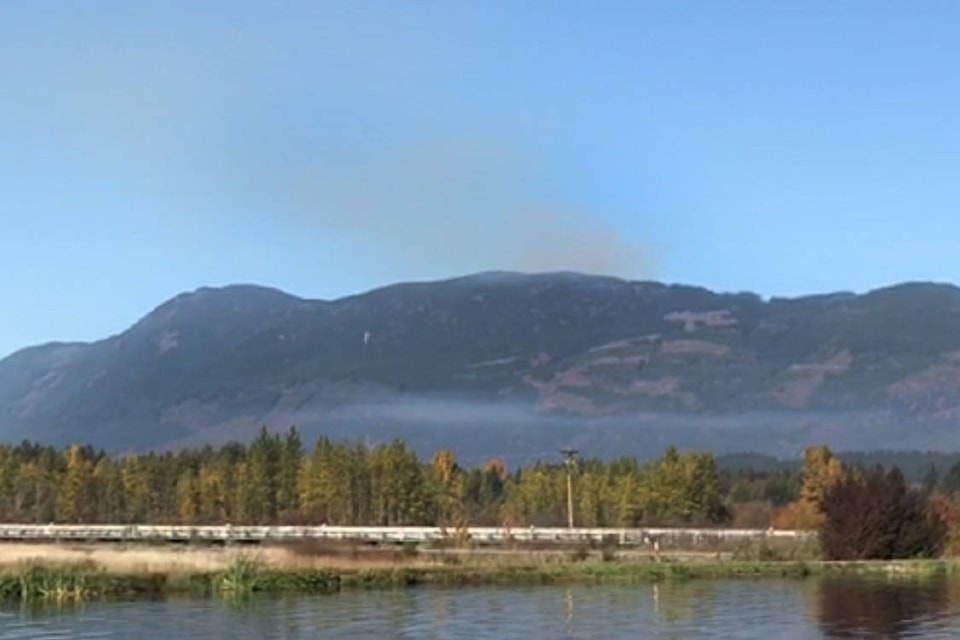Forestry crews are monitoring four slash burning sites north of Port Alberni whose smoke has caused concern in the Alberni Valley.
The sites—labeled Gretchen Creek 1, 2 and 3 as well as Mount Irwin/ Horne Lake on the BC Wildfire website—are controlled slash burns in areas of high elevation, says fire information officer Donna MacPherson of the Coastal Fire Centre. They started a week to 10 days ago.
“It’s a resource burn, done under a burn plan,” she explained. These types of fires, called Category 4, are designed to burn slash piles as well as any detritus between piles left on the ground as a result of logging activities.
“From our standpoint, we want this stuff gone,” she explained, so it doesn’t provide fuel for fires during the summer fire season.
Because of a temperature inversion and uncharacteristically low relative humidity for the area—Effingham Inlet weather station on the west coast was reporting 20–30 per cent relative humidity, which is unheard of in a rainforest at this time of year, MacPherson said—conditions became dry, and the smoke stayed around the area instead of moving off. The dry conditions caused these burns to spread beyond the area listed in their burn plans.
The Mount Irwin fire was supposed to be within two hectares, and the three Gretchen Creek fires were to be between 1.5–2 ha. each. “Those four have nominal growth beyond the burn plan,” MacPherson said.
“The burn left the square in the burn plan. It’s a low intensity ground fire” that is creeping along underneath the trees, “probably about knee high.”
On Tuesday, a helicopter was in the air to monitor the sites while six ground-based firefighters and a water tender were at two of the sites. One of the Gretchen Creek sites is in a steep area and is only being monitored at this time, she said.
The helicopter was not dumping water on any of the fires.
All four of the sites north of Port Alberni are owned and managed by the same logging company, but MacPherson was not able to name the company, citing privacy regulations. She did say that the cost to manage the burn areas is being paid for by the logging company.
“We sent officers out to make sure they are complying,” she said.
There is also a planned slash burn near the Comox Valley that is visible closer to Cumberland, MacPherson said.
There is a bigger fire in southern Vancouver Island, near Sooke, that has also slipped out of its prescribed burn area and grown to 40 hectares. MacPherson said the burn plan for that particular fire was 30 hectares, and it is visible from Sooke.
“It was the same concerns that people had. It’s still not threatening anything because it’s such a low-intensity fire,” she said.
Because of changes to terminology in the way wildfires are labeled in B.C., these fires are showing on the BC Wildfire website that they are “out of control”. To a member of the public, that means something very different than to a wildfire management team member, MacPherson explained.
“It’s either ‘out of control’, ‘being held’ or ‘modified response,’” she said. “It’s a technical term.”
British Columbia has made the terminology changes to conform with a new Canada-wide standard, which will make it easier when fire crews from other provinces are sent to fight inter-provincial fires.
“It’s hard for our public to wrap their heads around it. Ontario has been using (the term) for about five years and they’re fine with it.”
The good news is the temperature inversion is over, and Arctic outflow winds are picking up, so the smoke should clear. Wet weather expected at the end of this week will also assist with the burning.
The Sooke area fire will continue to burn until the cold, wet weather extinguishes it naturally, but it will stay active on the BC Wildfire website until forestry crews monitoring it are satisfied that it’s completely out, she added.
The same will hold true for the Gretchen Creek and Mount Irwin fires—they will be listed as active until they’re out, but they’re no threat. “It’s not a forest fire like people think of a forest fire,” she added.
